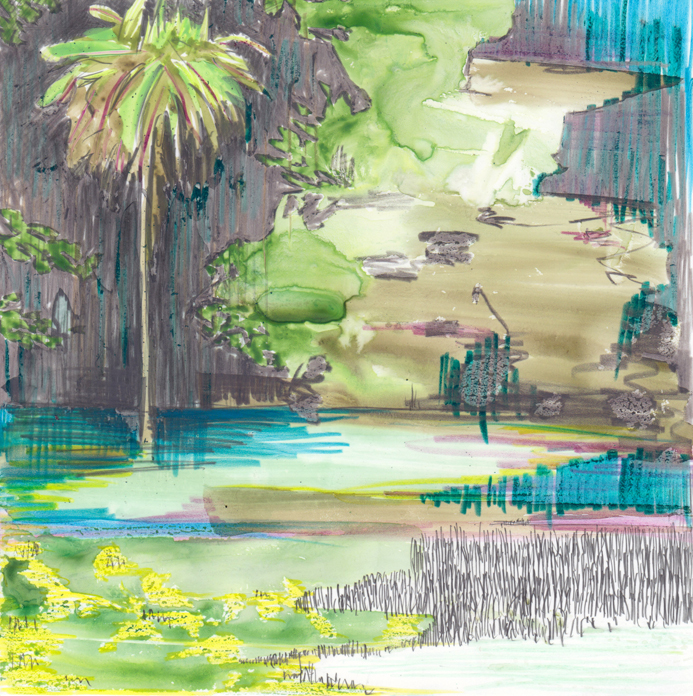
I tell people, sometimes, when the topic is at hand, that I love to paint, and that I think I’m pretty good at it. I sometimes get the idea to do a whole bunch of paintings, and then I usually don’t. I do draw more regularly, and funnily, the way I draw incorporates a whole lot of painting (and printmaking) knowledge, so, I’ve begun to think that it’s not so much that I love to paint as it is that I love to draw.
There’s a different mentality in drawing compared to painting–at least for me. Something immediate, direct, intuitive and confident. Painting, when it’s not done like a drawing, is more systematic. I’m good at that, certainly, but it’s somewhat boring.
Painting, as in the art-world capital-P PAINTING (okay, the all-caps-art-world-painting), is the medium that eradicates all the rest, categorically speaking. There could be a preparatory drawing under that paint, but it’s a painting. The canvas could be covered by a bunch of screenprints, but it’s a painting. Someone who is known as a painter could make a bunch of prints, but everyone is a-okay with thinking of them as a painter first–but flip that, have a self-identified printmaker who also paints, and people are like “why do you identify as a printmaker?”. Even our iconic friend, India Ink, suffers from the steamroller media-categorization of painting, though a bit in reverse–why? You use a brush, right? But also a pen? But–oh, damn. It’s called “ink”, and it’s on paper, therefore it’s a drawing. Or a “wash”. But not a painting. Maybe it’s an illustration. Or a work-on-paper? Or mixed media?
I hate the term mixed media so much. It renders everything that is not paint invisible. Except goats. Which is probably why Rauschenberg used one in one of his mixed media works.
There are a lot of absolutist statements I make to my students (lol), and one of them is that if a technique is essential to a work–that is, the marks could only have been made in that one particular way–then the work could/should be identified by that technique. Screenprints on canvas? Screenprint. Drawn marks on Yupo? Drawing.
In printmaking, we also have the concept of hand-work, or hand-coloring. When I’m snippy (which is often), I like to describe certain things that other people call paintings as prints with hand-coloring [See: Andy Warhol’s many works]. We also have the concept of the substrate–if you print something on paper, you identify it as such (often with the exact type of paper). If you paint on canvas prepared with gesso, then that’s your substrate. You can also draw on canvas prepared with gesso, of course, which is why it’s fairly dumb to link a substrate to an entire category of art.
Frank Stella made a bunch of wall sculptures using paint, canvas and wood supports, for example, but most folks think of those as paintings. To be fair, they still are paintings–but also not. They amusingly challenge the wall + canvas/stretcher substrate = painting equation, which is exactly what Stella was doing with them. Why is a painting not a sculpture? At what point does a painting stick out far enough from the wall to be considered a sculpture?
Because painting is the medium to steamroll all other media, the answer is: never. It never sticks out far enough to become a sculpture.
The best thing to do, I think, is to simply list the materials–and the techniques–that went in to the creation of a work. Simple. But why also the technique? Here’s what you’ll find at the Andy Warhol Foundation, for example–when you look at the way they describe Warhol’s works on their website, you’ll see something like: “acrylic and silkscreen ink on canvas”. I like to envision Andy himself hand-painting all the halftones (and the trompe-l’oeil masterwork of apparent screen bleed-through, too!) with screenprinting ink. It’s a heartwarming image!
What I might write, were I the Andy Warhol Foundation, would be something more like: “Found newspaper photograph screenprinted in halftone on canvas prepared with housepaint and later stretched. Printed by Specific Printername.” It tells you both what and how (as well as who–come on, don’t tell me you thought he actually pulled every screenprint himself, did you? If so, you really need to revisit why his studio was called “The Factory” . . . ), which are interesting, right?
Anyway, those fingerprints in the work above? They’re there because it was my first time using Yupo with wet media, and I didn’t realize that it holds grease just like a polymer offset litho plate–but it does! I was thinking I should test Yupo as a litho plate one day, when I’m both bored and set up for it. Insert thinking face emoji here.